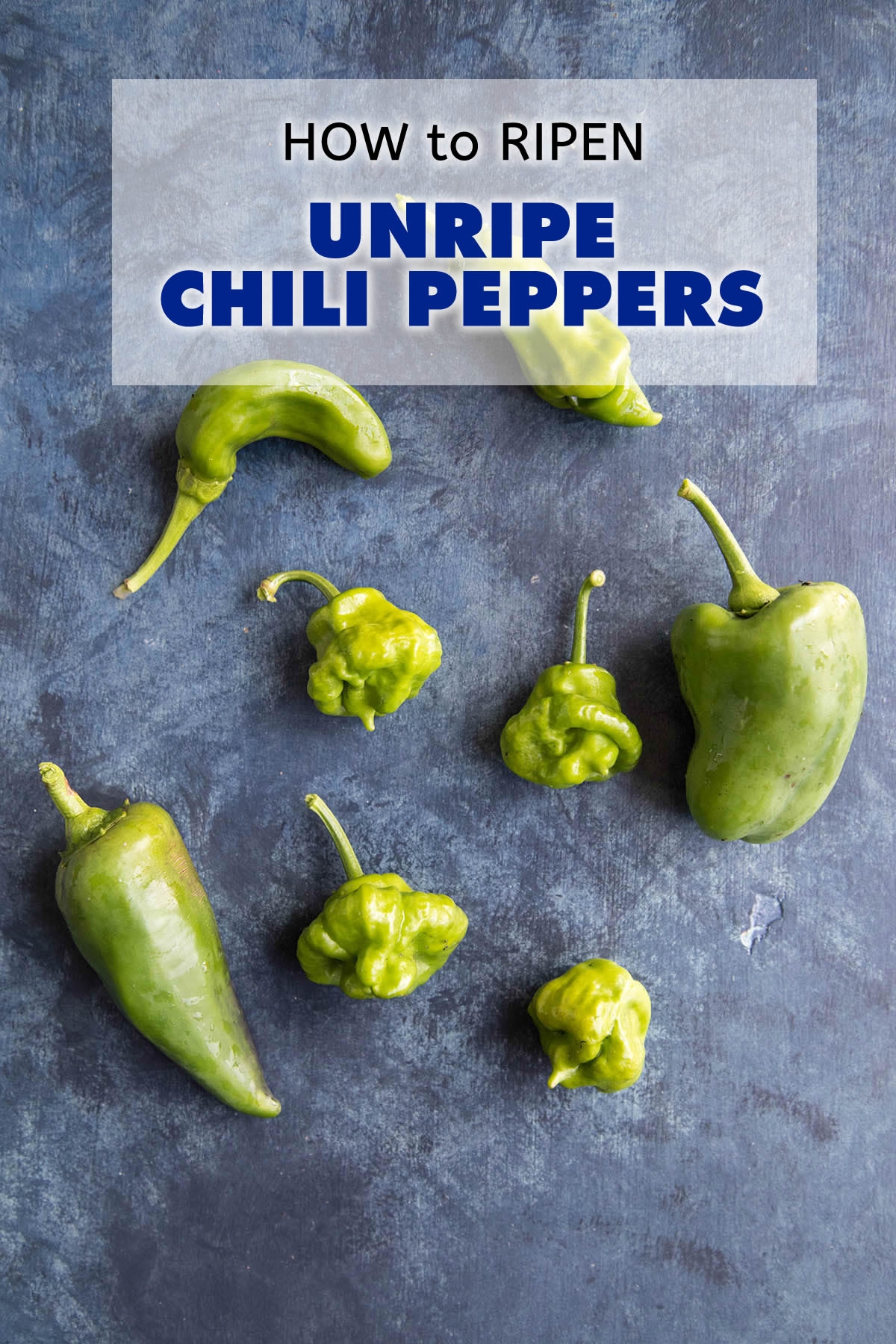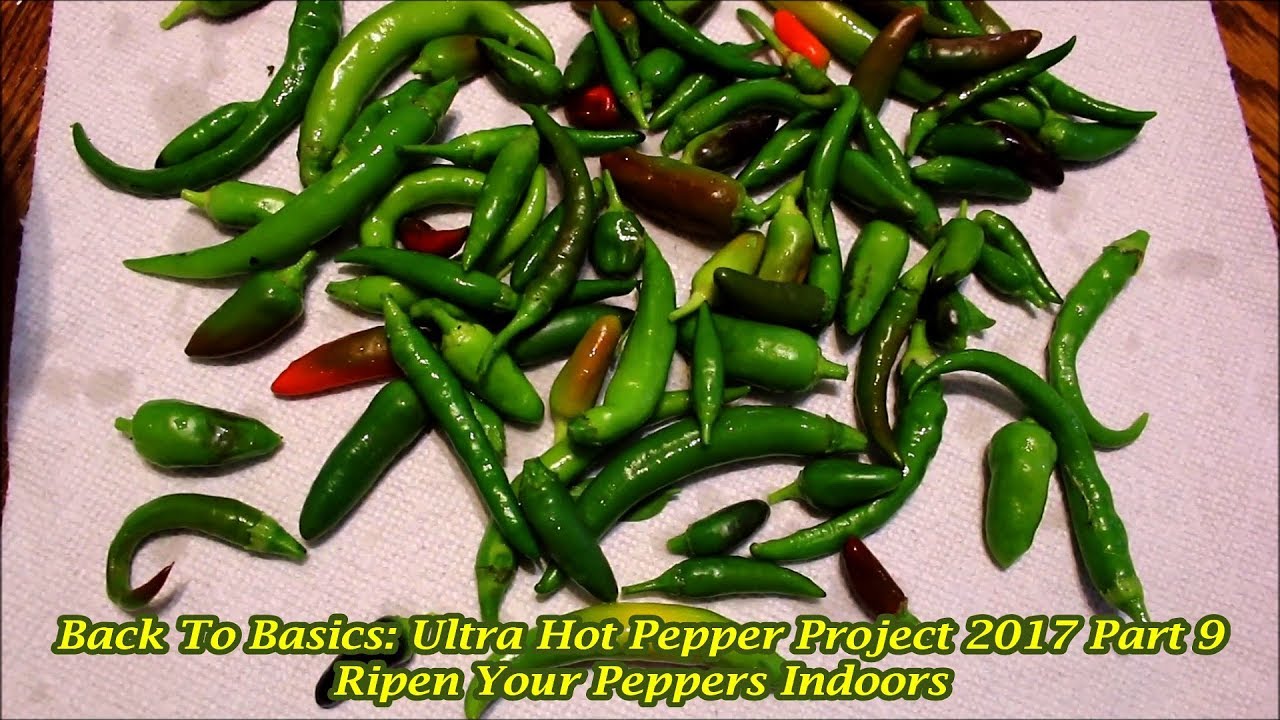To ripen peppers indoors, place the peppers in a sealed paper bag with a ripe banana. The natural ethylene gas produced by the banana will speed up the ripening process of the peppers.
Growing your own peppers can be a rewarding experience, especially when you get to harvest them at their peak ripeness. However, sometimes the growing season is cut short due to unexpected changes in weather or pest infestations. In such cases, you may find yourself with a batch of unripe peppers that need a little extra help to reach their full potential.
Fortunately, there are simple methods you can use to ripen peppers indoors, allowing you to enjoy the fruits of your labor regardless of external factors. This article will guide you through the process and provide useful tips to ensure your peppers mature evenly and deliciously.

Credit: www.chilipeppermadness.com
Why Ripening Peppers Indoors Is Beneficial
Ripening peppers indoors offers several benefits, such as extending the growing season and protecting the fruit from pests and adverse weather conditions. With proper care and attention to temperature and lighting, you can successfully ripen peppers indoors and enjoy a bountiful harvest.
| Why Ripening Peppers Indoors is Beneficial |
| Shortage of warm or sunny outdoor space: |
| Growing peppers indoors allows gardeners who lack warm or sunny outdoor spaces to still enjoy a bountiful harvest. Peppers thrive in warm and sunny conditions, which can be challenging to achieve in certain climates or when outdoor space is limited. By bringing peppers indoors, gardeners can provide the optimal growing conditions needed for peppers to ripen properly. |
| Extend the growing season: |
| Ripening peppers indoors extends the growing season beyond the limitations of outdoor growing. In many regions, the outdoor growing season for peppers is relatively short due to cooler temperatures and frost. By transitioning peppers indoors, gardeners can continue to nurture the plants and harvest ripe peppers well beyond the typical outdoor growing season. |
| Protection from pests and diseases: |
| Indoor cultivation provides a level of protection against common pests and diseases that can plague outdoor pepper plants. Aphids, caterpillars, and fungal diseases are just a few examples of the challenges peppers face when grown outdoors. By bringing the plants indoors, gardeners can control the environment and eliminate or minimize the risk of infestations and diseases, leading to healthier pepper plants and a higher yield. |
Choosing The Right Peppers For Indoor Ripening
Choosing the right peppers for indoor ripening is crucial to ensure successful results. When selecting varieties, it is important to consider their ripening time. Opting for varieties that ripen faster can expedite the process and provide you with fresh peppers in a shorter time frame. Additionally, considering the space and light requirements is important. Indoor ripening requires sufficient sunlight or artificial light, so make sure you have the appropriate conditions in place.
Furthermore, opting for smaller-sized peppers can also contribute to quicker ripening. Smaller peppers generally require less time to reach maturity. By following these guidelines, you can ripen peppers indoors effectively and enjoy the fruits of your labor sooner.
How to Ripen Peppers Indoors: Step by Step Guide
Preparing The Environment For Indoor Ripening
When it comes to ripening peppers indoors, it is important to create the right environment for optimal results. This begins with choosing suitable containers, which should be large enough to accommodate the pepper plants and provide enough space for root growth. Additionally, it is crucial to provide adequate sunlight or artificial light to promote photosynthesis and the ripening process. Placing the peppers in a sunny window or utilizing grow lights can help ensure they receive the necessary light exposure.
In addition to light, maintaining optimal temperature and humidity levels is essential for successful indoor ripening. Peppers prefer temperatures between 70-80°F (21-27°C) during the day and slightly cooler temperatures at night. To achieve the desired humidity, misting the plants with water or placing a tray of water nearby can help increase humidity levels around the peppers. These factors combined create a favorable environment that encourages peppers to ripen efficiently.
Caring For Indoor Pepper Plants
When it comes to caring for indoor pepper plants, providing the right amount of water and moisture is crucial. Peppers need moist soil, but it is important to avoid overwatering as it can lead to root rot. A good way to check if your pepper plants need water is to stick your finger about an inch into the soil – if it feels dry, it’s time to water. On the other hand, if the soil feels too wet, hold off on watering until it dries out a bit.
Fertilizing peppers is essential for optimal growth. A well-balanced organic fertilizer with a higher potassium content can help promote fruit production. It is advisable to start fertilizing the plants when they are about six to eight weeks old and continue every two weeks until harvest.
As pepper plants grow, it is important to provide support by staking or trellising them. This helps to keep the plants upright and prevent them from toppling over under the weight of the fruit. Pruning is also necessary to promote airflow and prevent disease. Remove any dead or yellowing leaves and branches to maintain plant health.
By following these guidelines, you can successfully care for your indoor pepper plants and enjoy a bountiful harvest.
Monitoring And Facilitating Pepper Ripening
Monitoring and facilitating the ripening process of peppers is crucial to achieving optimal results. One essential aspect is knowing when the peppers are ready for picking. This can be determined by observing their color, which should be vibrant and uniform. Unripe peppers are typically green, while ripe peppers can exhibit colors such as red, yellow, or orange, depending on the variety.
An effective method for ripening peppers indoors is using ethylene. Ethylene is a natural plant hormone that triggers the ripening process. You can place a ripe fruit, such as a banana or apple, in a paper bag with the unripe peppers. The ethylene gas released by the fruit will accelerate the ripening of the peppers. Ensure the bag is sealed properly to concentrate the ethylene gas.
A popular technique for accelerating pepper ripening is the paper bag method. Place the unripe peppers in a paper bag, folding the top to seal it. This creates a confined space that traps ethylene gas naturally emitted by the peppers, promoting ripening. Check the peppers regularly to monitor their progress.
| Ethylene-based ripening methods: | Accelerates ripening process |
|---|---|
| Paper bag method for accelerated ripening: | Traps ethylene gas to speed up ripening |
Troubleshooting Common Issues With Indoor Pepper Ripening
When ripening peppers indoors, it is common to encounter slow ripening issues. One possible reason for this is nutrient deficiencies, which can be addressed by providing the peppers with the necessary nutrients. Fertilizers rich in potassium and phosphorus can help stimulate ripening. Additionally, managing pests and diseases is important for the proper ripening process. Pests such as aphids and diseases like powdery mildew can hinder the ripening of peppers.
Regularly inspect the plants for any signs of pests or diseases and take appropriate measures to control them. Using organic pest control methods or seeking professional advice can help maintain a healthy environment for the peppers to ripen. With proper care, nutrient management, and pest control, you can successfully ripen peppers indoors.
Harvesting And Enjoying Indoor-ripened Peppers
Proper harvesting techniques are crucial for enjoying the full flavor of indoor-ripened peppers. First, it’s essential to wait until the peppers are fully mature. Look for vibrant colors, firm texture, and smooth skin. Harvesting peppers with scissors or pruners is recommended to avoid damaging the plant. Gently twist the pepper off the stem, ensuring the whole fruit is harvested without leaving any part behind.
Once harvested, it’s important to properly store and preserve your peppers. Keep them away from direct sunlight and store them in a cool, well-ventilated area. Storing them in a paper bag can help absorb excess moisture and extend their shelf life. Consider preserving your peppers by drying, freezing, or pickling them for future culinary use.
Now that you have your indoor-ripened peppers ready, it’s time to enjoy the fruits of your labor! Experiment with delicious recipes that highlight the unique flavors of peppers. From spicy salsas and savory stir-fries to stuffed peppers and tangy hot sauces, the possibilities are endless. Get creative in the kitchen and savor the rewards of your successful indoor pepper-growing journey.
Frequently Asked Questions On How To Ripen Peppers Indoors
Do Green Peppers Turn Into Red Peppers?
Green peppers can turn into red peppers as they mature. As they ripen, green peppers gradually change color to red.
Can You Hang Pepper Plants To Ripen?
Yes, you can hang pepper plants to ripen them. Hanging the plants allows air circulation and helps the peppers ripen evenly. Make sure to choose a spot with good light and moderate temperature.
How Do You Ripen Peppers In A Paper Bag?
To ripen peppers in a paper bag, place the peppers inside the bag and fold it closed. The bag traps ethylene gas, which speeds up the ripening process. Leave the bag in a warm place, like a sunny windowsill, and check the peppers daily.
They should ripen within a few days.
How Long Does It Take For Peppers To Ripen Indoors?
Peppers typically take 2 to 3 weeks to ripen indoors, depending on the variety and growing conditions. Providing adequate sunlight, warmth, and consistent watering will help accelerate the ripening process.
Conclusion
To sum it up, ripening peppers indoors is not only a feasible option but also a convenient one. By following the tips and techniques mentioned in this blog post, you can successfully ripen your peppers without relying on the outdoor weather conditions.
From providing adequate sunlight and warmth to monitoring the ripening process, these simple steps will ensure a bountiful harvest of flavorful peppers. So go ahead and give it a try, and enjoy the satisfaction of picking perfectly ripe peppers straight from your indoor garden.
Happy gardening!

